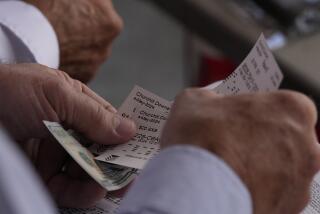A Giant Among Us
- Share via
The amount of money wagered through legal gambling in America has become so immense so quickly that it would be irresponsible to not thoroughly study its social, economic and political impact on the nation.
That’s why Congress passed, and President Clinton recently signed, legislation to create the National Gambling Impact and Policy Commission. The commission will have nine members, with three to be selected by Clinton and three each by the leaderships of the House and the Senate.
Its purposes are many-fold. Among them: to explore the relationship between gambling and crime; to assess gambling’s impact on state and local economies, individuals and families, and, presumably, its reach into the political realm.
The gambling industry lobbied hard against this legislation, and then, when it became apparent that the bill could not be stopped, to water down the commission’s mandate. Proponents of the bill now anticipate a push to stock the commission with members favorably disposed to gambling interests.
What is needed on the panel is a mix of legal and political experience, knowledge of the budgetary and economic realities faced by states, localities and Indian lands where gambling takes place, and a clear sense of the social costs of uncontrolled or addictive behavior regarding gambling. If the commission’s work is properly done, it will serve as an invaluable source of information for communities and local and state governments that are considering whether to allow various forms of legal gambling or an expansion of what they already have. The sheer size of the industry and its impact demand at least that.
In 1974, Americans spent $17 billion on legal gambling. By last year, the figure had grown to $550.3 billion wagered. That rivals the gross domestic product of some large nations--Indonesia, for instance. If Americans annually devoted that amount to drawing down the $4.9-trillion federal deficit, we could be rid of it in less than nine years.
State-sanctioned casino gambling accounts for more than 40% of all gambling revenues in the United States, with much of the recent activity involving riverboat gambling. Gaming on Indian reservations accounted for the second-largest piece of the pie, followed by state-run lotteries and horse racing.
One productive step might be making a cost-benefit analysis of opening up a market to gambling. There have been quantifiable statistics, for example, on the effects on local businesses when money that might otherwise be spent there is diverted to wagering. And there is the nagging question of whether the poor become the easiest targets and the biggest spenders in the search for easy money.
Gambling is not about to fade from the landscape, and we are not suggesting that it should. But an informed assessment on gambling is much needed and long overdue.
More to Read
Sign up for Essential California
The most important California stories and recommendations in your inbox every morning.
You may occasionally receive promotional content from the Los Angeles Times.













